16 Chapter 16: Envisioning a Sustainable American Way of Life
So now we’ve studied, sometimes through economic quadrifocals (neoclassical, ecological, and institutional economics plus political ecology), topics as critical and diverse as accelerating climate change, balancing the electrical grid with sustainable energy, irrigation efficiency, managing nutrient runoff from agricultural watersheds, and even living within the Earth’s photosynthetic capacity. We’ve seen how maintaining natural capital conserves bio-diversity and ecosystem service provision. These are the pragmatic issues of natural resources sustainability in the present. What kind of place would your hometown and the surrounding countryside become in the process of resolving these natural resources sustainability issues? Would it be substantially different than it is today? Would you want to live there?
Change is a difficult thing to achieve. Machiavelli, the great Italian master of realpolitik, said centuries ago in his masterpiece The Prince:
It ought to be remembered that there is nothing more difficult to take in hand, more perilous to conduct, or more uncertain in its success, than to take the lead in introducing a new order of things, because the innovator has for enemies all those who have done well under the old conditions, and lukewarm defenders in those who may do well under the new. This coolness comes partly from fear of the opponents—who have the laws on their side—and partly from the incredulity of men, who do not readily believe in new things until they have had long experience of them.
So with Machiavelli’s warning in mind, let’s paint a picture, a realistic vision, of a more sustainable America in the mid-21st century that can earn more than lukewarm defenders, perhaps even steadfast advocates, by attempting to overcome your incredulity. Remember, it’s not a choice between the present and this or some other vision of the future because, as we have seen, the way things are now cannot be sustained. Rather, it’s a choice between a sustainable vision and a degraded version of the present where the sea is flooding coastal cities, damaging extreme weather events have become the norm, water tables are dropping, freshwater bodies and coastal waters are filling with nutrients. More commonly beyond the borders of the U.S., forests are receding, deserts are advancing, and species are going extinct. To quote Confucius, “if we’re not careful, we’ll end up where we’re going.” We need a vision, if not a rigid plan. To quote another of my favorite philosophers, Yogi Berra, “if you don’t know where you’re going, you end up someplace else.” So let’s start developing a sense of where we’re going by getting in a time machine and dropping in on your hometown—in 2050.
Your Hometown, 2050
Nobody drives anymore, except recreationally in the beautiful countryside. Then it’s in an electric car, usually rented and self-driven. No, people are not crowded into buses and uncomfortable commuter trains, though the bigger cities do have heavily used subway systems. Rather, the narrow tree-lined streets are abuzz with little one-seater electric robot taxis (Figure 16.1) ferrying folks around town. It’s so simple; you just click your cellphone app and in less than a minute a robot taxi greets you and asks where you’re going, then zips through town and drops you off at your destination. Tailgating and tight traffic is no problem for these well-programmed robots, so they pack the streets, slipping elegantly past one another at the traffic circles that dot the center of town; after all, why would a robot taxi stop at a busy intersection when there’s no reason to? The only time they stop is when they’re picking up and dropping off their passenger or when they’re re-charging because, after all, they are an integral part of the electrical grid, storing electricity, providing it during peak demand, and driving on sunshine or powered by the breeze when they have a passenger to deliver.
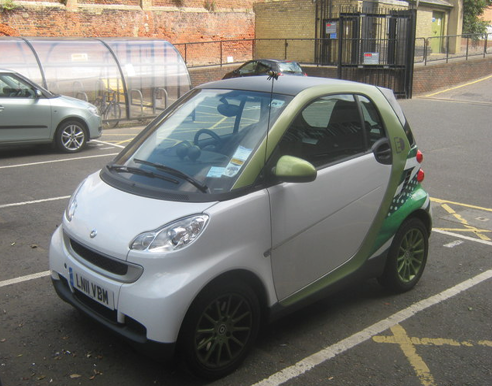
When robot taxis were first introduced in the 2020s by Uber and Lyft, it was tricky integrating small, responsive robot cars and big sluggish driver cars, but by the 2030s, most urban dwellers had come to the conclusion that battling traffic behind the wheel was a dangerous, stressful, and expensive waste of time and money, so robot taxis became the norm. By the 2040s, most cities and towns had banned gas-powered driver cars from their central, most densely populated sections so they could capture the substantial advantages of redesigning the streets and sidewalks to eliminate parking and pack the robot taxis closer together. It made downtown an even more fun place to be.
A lot of folks are strolling and chatting on the sidewalks and the cute little footbridges that get pedestrians across these robot taxi packed streets. Others are on electric scooters, segways, or bikes. With internal combustion engines only remaining in a few rural areas, the streets aren’t silent but sound more like a swoosh than a roar, even when the robot trucks go by delivering goods with a bigger swoosh. Conversations on the sidewalks and footbridges and drinking and dining in the sidewalk cafes are not interrupted by the sound of engines. Air pollution is also becoming a thing of the past.
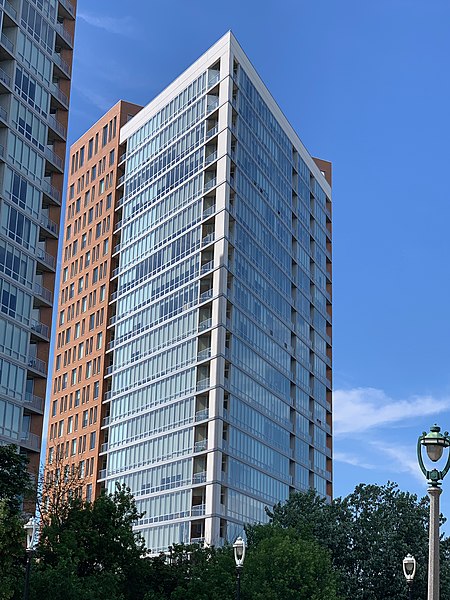
Millennials started the process of taking back the city and making it a great place to live but GenZers have nearly all taken up abode there, mostly in nicely outfitted apartments and condos in quaint two-to-four story, energy-efficient buildings near the center of town, sometimes upstairs from sidewalk-level businesses. These abodes are packed with all the latest electronics plus an essential new appliance—the delivery elevator from the robot car drop-off that brings every restaurant, pub, and store in town to your kitchen or living room. The apartments feature little individual gardens, decks, and patios adjacent to larger community gardens and parks shared by the buildings surrounding them. Since about 2030, most new buildings use geothermal heating and cooling systems replacing electrically powered AC units and cutting drastically the use of natural gas in basement furnaces. Due to passive solar design, heat-rejecting windows, daylighting, and excellent insulation, gas furnaces need only be turned on in the coldest weather (Figure 16.2). In the newest buildings there is no natural gas use at all, with heating provided by solar hot-water units. While some still feel that a suburban house with a large yard is necessary to raise a family, many have abandoned garages and driveways in favor of little robot taxi pickup spots. Most parents feel that kids over ten are OK to take the robot taxi to the park or to meet their friends, so no one remembers old phrases like “soccer mom” and “minivan.”
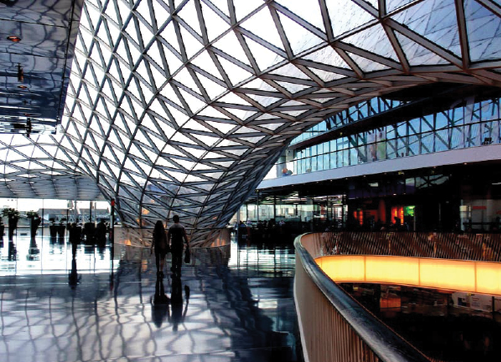
The robot taxi traffic is especially busy around the Hyperloop stations (Figure 16.3). The first hyperloops opened in the mid-2020s, one serving all of Germany from its major cargo port at Hamburg, and one connecting passengers between Mumbai and Pune in western India. By the 2030s, hyperloops were becoming the primary mode of medium-to-long distance transportation for both people and cargo in the U.S.
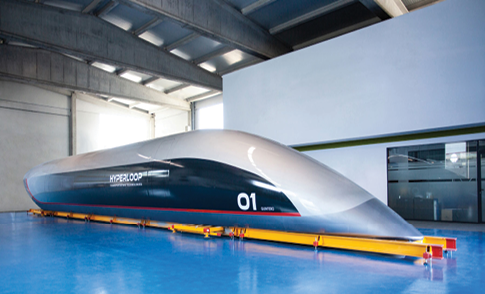
Elon Musk’s original 2013 concept combines magnetic-levitation rail technology, already widespread at the time, with a vacuum tube to produce nearly frictionless, highly energy-efficient transport in small, comfortable 4–16-seater pods (Figure 16.4). Traveling at jet airline speeds in underground or aboveground tubes, passengers can simply grab the next available pod from the Hyperloop station—like they have done with subways for over a century. Their cell phones give them all the information they need to get on the right car at the right time while also handling all the billing, so there are no awkward lines to make sure people have a ticket. What even the most optimistic projections didn’t realize is how much Americans would enjoy coasting along at 300–600 miles per hour while drinking good coffee and eating sandwiches, pizza, or Chinese food as they use the wireless Internet, chat on the cell phone or with the person sitting next to them, or take a nap. Unlike in Europe and Asia, passenger rail never caught on in the U.S. outside a few of the largest urban areas. Yet the Hyperloop has not only replaced all 20th century-style passenger and freight rail, it has also replaced most flights of less than 1,000 miles with their annoying security lines, massive petroleum consumption, and poorly designed air-to-land connectivity. In comparison, Hyperloop stations are located in city centers and downtown so Hyperloop-to-robot taxi connections are a snap. With a national ridership of over 10 million passengers each day, most of the thousand or so Hyperloop stations have become commercial hubs, monitored by a cop on a segway, bustling with restaurants, shops, hotels, and nightlife, replacing the fast-food joints and gas stations at interstate exits and the overpriced captured markets at airports.
Running on electricity and hyper-efficient in their frictionless environments, the Hyperloops are powered by solar, wind, and modern nuclear electricity and so, like the robot taxis, are essentially emission-free. In 2050 Hyperloop lines serve most of the connections that the interstate (really inter-metro) highways had served in the 20th and early 21st centuries, but the build-out continues as Hyperloop lines evolve into Hyperloop networks across the U.S. map and into Canada and Mexico. Most people remember traffic jams and car crashes, which at the beginning of the 21st century killed a horrific 30,000 Americans each year and maimed several times that many, but no one remembers them fondly. With most businesses and homes using advanced video-conferencing technology on big screens that makes you feel like you’re there, long trips are also less needed than they once were.
Throughout the U.S., it is the Age of the City, some smallish, some very large, but suburban blight is a problem. Car-oriented development has, unfortunately, outlasted the car it was designed to serve, and so the sprawl remains, even as it slowly empties of people. Outlying towns and villages with lovely natural surroundings have their charms for many, but largely empty highways serving largely empty box stores and malls charm no one. For them, the theme is “the future has arrived, but it’s unevenly distributed.”
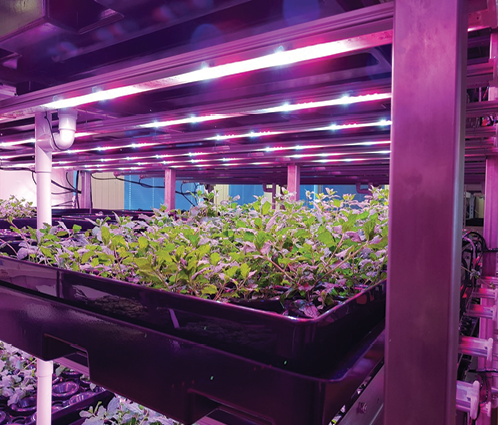
Fortunately, some of what had been suburbs has taken on a new role in agriculture. For high-quality fruits, vegetables, nuts, herbs, and so forth, which make up much of people’s diets, farming has moved indoors. CRISPR and other gene-editing techniques have produced super-crops that have high yields and nutritional value and taste delicious. These are grown in advanced greenhouses (Figure 16.5) with controlled environments that make climate almost irrelevant. Plants photosynthesize from the red and blue portions of the light spectrum, so that’s what LED lights provide—24 hours a day, 365 days a year—at the perfect temperature and humidity and with elevated carbon dioxide levels. So not only are the crops genetically engineered, they are engineered to optimally utilize the optimized environments in which they grow year-round.
Water circulates within the greenhouse, so there is no water consumption, while only the nutrients contained in the food leave the greenhouse. These are obtained locally from sewage treatment plants, dairies, and chicken-egg farms. No nutrients run off or evaporate as pollution. With robots doing the picking, harvesting, and loading, and small electric robot trucks delivering to local grocery stores and restaurants, most of the jobs in agriculture have become doing all this engineering, matching supply and demand over time so that everything is fresh, and making sure it’s all done at a profit.
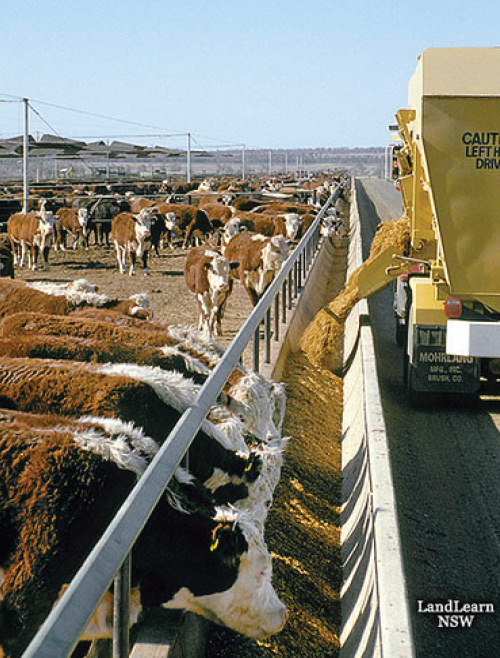
Out in the countryside, especially in fertile belts of the Midwest, you still find amber fields of grain – under the wind turbines. These fields supply staples like wheat as well as corn and soybeans for the many medium-size pig and chicken-egg farms, as well as hay for dairies. These compete with plant-based, high-protein foods, first introduced as Beyond Beef and the Impossible Burger around 2020. Cotton also grows now in the fertile Midwest due to the warmer climate, and corn and soybeans can be grown across Minnesota and the Dakotas and on into Canada. Beef feedlots (Figure 16.6) have been phased out, however, along with giant pig and chicken feedlots, with livestock raised in smaller, more humane environments. The outlawing of antibiotic use for livestock in order to preserve their essential germ-killing power for humans, the elimination of subsidies, regulations to restrict greenhouse gas and nutrient pollution, and a slow decline in consumer preferences for meat forced livestock raising into new, more integrative modes that produce a better product in a more sustainable way. Beef cattle have returned to pastures and rangelands where new grazing techniques, like planting tannin-containing legumes, make finishing—force-feeding corn to cattle to quickly double their weight before they perish from it—unnecessary. Biofuels are also a thing of the past, along with the gasoline they were once mixed with.
These shifts in the U.S agricultural system have allowed two other goals to be pursued more vigorously. First, climate change has wreaked havoc on agricultural systems around the world, but this has opened up even greater opportunities for U.S exports to fill the ever-widening shortfalls. So corn, wheat, soybeans, and other major crops that were once used to produce ethanol for gasoline or force-fed to cattle are now exported at a profit to a hungrier, but more affluent, Asia and Africa. Second, the U.S. agricultural landscape has blossomed with ecosystem services like carbon storage, wildlife habitat (including for pollinators like bees), floodwater storage, and water filtration. This has been accomplished through policies to incentivize wetland and soil restoration and the integration of semi-wild land uses with crop production. Coastal folks who once referred to the U.S. agricultural heartland as “fly-over states” now sometimes take the Hyperloop there on vacation to see the bucolic farmscapes dotted with wind farms and vibrant towns.
The year 2050 marks two seemingly paradoxical outcomes; it is the year the U.S. finally achieved zero net carbon emissions at the same time that the world witnessed the Year of Peak Warming. Globally, greenhouse gas emissions peaked in the 2020s (they peaked in the U.S. in 2008) and then started a brisk decline, but the climate system has lags. The most important one is the vast amounts of heat energy, many times more than the atmosphere can contain, that are stored ever-deeper in the oceans. So even after emissions peaked, declining emissions were still sufficient to warm the atmosphere, which continued to warm the oceans. Then the oceans started their decades-long process of releasing that excess heat back into the atmosphere, guaranteeing a warmed climate well into the 22nd century. Still, by rapidly reducing emissions through the 2020s, 2030s, and 2040s, the 2050 temperature peak nudged just over the goal of 1.5oC in warming. This enormous achievement reduced climate change from the existential threat to modern civilization it could have been had high emissions continued, to a difficult, expensive, ever-present but ultimately manageable problem. In the U.S., the most profound adaptations have occurred in coastal cities. New Orleans and Miami simply aren’t where they used to be. Boston, New York, Washington, Baltimore, Norfolk, Houston, and dozens of smaller coastal cities have had to retreat from their coastlines through carefully laid redevelopment plans. Florida had to be entirely re-thought as the Atlantic and Gulf of Mexico swallowed the beaches and delivered even more severe hurricanes.
As we saw above, specific crops are now grown in different states than they were at the start of the century. Once the leader in corn and soybean production, Illinois now leads in cotton while North Dakota and Minnesota lead in corn and soybeans. People take hurricane, wildfire, and heat wave alerts very seriously. But it all could have been far worse had mitigation not worked.
The U.S. greenhouse gas mitigation strategy has four major components. The first two are decarbonize the grid and electrify transportation. We’ve seen how wind and solar power, complemented by natural gas until electricity storage, modular nuclear power, and smart grid technologies catch up, was able to eliminate the vast majority of carbon dioxide emissions from the electricity sector. By then transitioning nearly all transportation to run on electricity, gasoline, diesel, and biofuels were phased out as well. In 2050 natural gas is still an important fuel for heating older buildings, but this is balanced by making the American landscape a net carbon sink, resulting in, for the first time in 2050, zero net carbon emissions.
We saw how the growth of forests in the eastern U.S. offset 11 percent of U.S. carbon emissions in the 2010s. This principle of let the forests grow with trees getting bigger and bigger, and covering more and more acres in the warmer, wetter, carbon dioxide-rich climate, is augmented by other carbon-absorbing tools: restore the wetlands and restore the soil. The final card is cull the herd. Reduced methane emissions from cattle and changes in land use from growing feed to growing ecosystems reduced emissions sufficiently to make the American landscape as a whole a carbon sink substantial enough to offset all remaining emissions from remnant fossil fuel use.
Together, these land management strategies also improved the health and beauty of the landscape and the prosperity of rural areas. Americans mostly live in the cities, but they see the countryside as a big playground and are willing to pay rural landowners substantially sums to make it one. While growing crops remains essential, most rural landowners, farmers, and ranchers now make more money on wind and solar energy projects, reimbursed carbon storage, and recreational use fees and easements than they ever made on timber or livestock grazing, so they see city folks as their market and allies more than as opponents.
Conclusion
So, would you want to live in this American town in 2050? Taking a lesson from Machiavelli, I find that a viable pathway to a more sustainable way of life doesn’t, and really can’t, involve sacrifices. People just aren’t willing to give up the things they love having, eating, and doing for a distant, collective goal—especially in this era of political polarization and leaderlessness, of disinformation and noise that drowns out the signal. Rather their response is the one Machiavelli illustrated. Their incredulity takes over and they defend their lifestyle against the theories of some pointy-headed intellectuals, mocked by social media.
Instead of sacrifices, the pathway to sustainability asks for a willingness to change for your own sake. Our lifestyles will actually be better, not worse, in this Hometown in 2050 than they are today. People will be healthier, safer, and have more fun things to do. The picture I’ve painted is not at all a back-to-the-land exercise in reminiscing about the world of our great-grandparents and returning to the good old days. Rather it’s very technological, full of cell phone apps, robots, the instantaneous, silent acceleration of electric vehicles, the elegant swooshing of giant three-bladed wind turbines, and the magic that turns sunshine into electricity. It accepts globalization as the inevitable stage in the progress of human civilization in which we now live. It’s driven by the private sector, with government, local as much as national, mostly playing the role of a fair referee enforcing well-thought-out, widely agreed-upon rules and providing some strategic carrots and sticks. So the pathway to sustainability isn’t alien; it’s American. And, as we’ve seen with reductions in water consumption, the decarbonizing of the economy, the sustainable energy revolution, and other already-achieved trends through which we are getting more with less, we’re already on the pathway to sustainability. We just need to see it more clearly, pave it with yellow bricks, so we can follow it faster and more directly.
Media Attributions |
|

